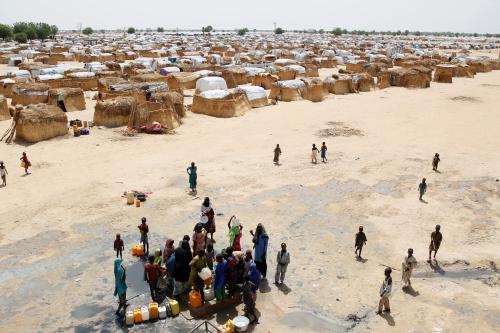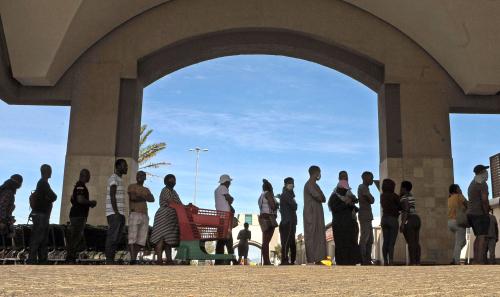2018 could be a landmark moment in understanding global poverty dynamics. In June, we reported the start of a new poverty narrative, one that brought the plight of Africa squarely into focus. In September, we also discussed an unprecedented tipping point in global wealth prospects: More than half the world is now middle class or richer, fueled by a rising Asian middle class. As Steven Pinker and others observed, the rise of the global middle class—and the implications on policies, industry, and political economy—might have been one of the most important “ignored” stories of 2018.
To prepare for the year ahead, data scientists at World Data Lab responsible for uncovering these findings have updated the World Poverty Clock to take into account recently released data and forecasts from the World Bank and IMF, as well as refinements in poverty measurement in India. The biggest headline from their work may be that when official numbers for India’s extreme poverty are published later this year, less than 50 million people will likely be living below $1.90 per day, compared to 268 million in 2011, the last year for which official data on Indian poverty are available.
Looking at poverty trends worldwide, World Data Lab now estimates that on New Year’s Day 2019, just under 600 million people across the world (excluding Syria) will live in extreme poverty. By 2030, this figure is expected to fall to some 436 million.
The good news is that 2019 will start with the lowest prevalence of extreme poverty ever recorded in human history—less than 8 percent. In all likelihood, this level will set the “ceiling” for a new era of even lower single-digit global poverty rates for the foreseeable future. The bad news, though, is that poverty reduction rates are expected to keep slowing down considerably over the next decade. Consequently, only 20 million people are likely to escape extreme poverty in 2019. At this rate, it will take five years for the global number to fall below 500 million—making it nearly impossible to end poverty by 2030.
Amid this context, several salient trends stand out, indicating a great divergence between stagnation in Africa and great progress in most other parts of the world (see Figure 1), notably India:
- India’s success. The soon-to-be-largest country in the world has been reducing extreme poverty fast and the world may have underestimated India’s achievements. India’s last household survey of 2017/18 (to be released in 2019) captures household consumption more comprehensively—it will include an adjustment for owner-occupied housing and measure other items in accordance with common international practices. World Data Lab anticipates the effects of these methodological adjustments will result in a level of extreme poverty in India today of 50 million people, which will come down to 40 million (a poverty rate of below 3 percent) by end 2019.
- Africa’s stagnation. In 2019, some 70 percent of the world’s poor will live in Africa, up from 50 percent five years ago. By 2023, Africa’s share will rise to over 80 percent (up from 60 percent in 2016). For Africa to end poverty by 2030, more than one person would need to escape poverty every second; instead, Africa currently adds poor people. However, there is light at the end of the tunnel. In 2019, for the first time since the enactment of the SDGs, Africa will start reducing the absolute number of people living in extreme poverty, albeit very modestly.
- The road to 2030. Asia will outperform every other developing region and in early 2019, the world’s largest continent will have an average poverty rate of below 3 percent. That share is projected to fall further to only 1 percent by 2025. Three Asian countries that will not end poverty by 2030 are Afghanistan, North Korea, and Papua New Guinea. South America currently has only a 4 percent aggregate poverty level, but rates are declining slowly. Disaggregated data suggest Venezuela, Suriname, and Bolivia appear off-track for ending poverty by 2030. They are joined by Guatemala, Honduras, Belize, and Haiti in Central America and the Caribbean.
In contrast to other regions where selected countries have on-going issues with poverty reduction, almost all of Africa, especially sub-Saharan Africa, is off-track for ending extreme poverty. Indeed, 13 African countries are expected to see an increase in the absolute numbers of extreme poor between now and 2030. Today, Nigeria is the “poverty capital of the world”. If it is unable to change its current trajectory, it will be home to 110 million people living in extreme poverty by the year 2030. The second position in World Data Lab’s Global Poverty Ranking is currently occupied by the Democratic Republic of Congo (DRC), which will enter 2019 with more than 59 million poor people and end in 2030 with 61 million under current trajectories. By the end of 2030, nine of the 10 countries with the most poor people will be in Africa, up from seven countries today (see Figure 2).
Figure 2. Global Poverty Ranking: African countries will represent 9 out of the top 10 by 2030
 Note: Rankings end 2018 and projections for end 2030; Source: World Data Lab projections (base case)
Note: Rankings end 2018 and projections for end 2030; Source: World Data Lab projections (base case)
In 2016, when the SDG era started, Africa accounted for just over 60 percent of global poverty. Today, it is over 70 percent. By 2030, it could be close to 90 percent. It seems clear that Africa remains the last frontier of the world’s effort to end extreme poverty by 2030.
Will 2019 be the year that global attention, energy, and resources are finally mobilized to improve the situation in Africa, the last frontier of global poverty?
Note: For questions on the underlying data model and access to the data please contact Kristofer Hamel ([email protected]).
The Brookings Institution is committed to quality, independence, and impact.
We are supported by a diverse array of funders. In line with our values and policies, each Brookings publication represents the sole views of its author(s).









Commentary
Rethinking global poverty reduction in 2019
December 13, 2018